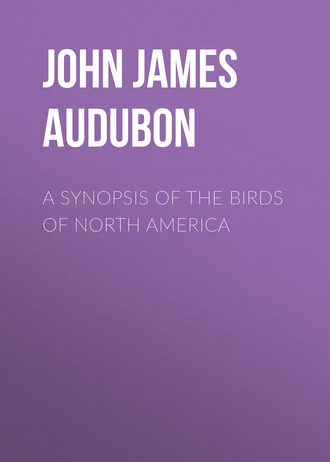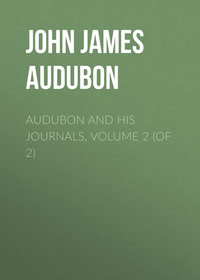 полная версия
полная версияA Synopsis of the Birds of North America
Male, 143/4, 251/2.
Very common during autumn on the Ohio, Missouri, Mississippi, and all their tributaries, as well as in all the Atlantic Districts, to Texas. Breeds from the Great Lakes to the Fur Countries. Migratory.
Podiceps cornutus, Bonap. Syn. p. 417.
Podiceps cornutus, Horned Grebe, Swains. & Rich. F. Bor. Amer. v. ii. p. 411.
Horned Grebe or Dobchick, Nutt. Man. v. ii. 254.
Horned Grebe, Podiceps cornutus, Aud. Orn. Biog. v. iii. p. 429; v. v. p. 423.
490. 4. Podiceps auritus, Lath. Eared Grebe
Plate CCCCIV. Adult and Young.
Male with the bill considerably shorter than the head, rather stout, bluish-black; feet dusky grey externally, greenish-grey on the inner side; a tuft of very long loose feathers on each side of the head, behind the eye and covering the ears, orange; head and neck all round deep black; upper parts brownish-black, the wings greyish-brown, with a broad patch of white, the secondary quills being of that colour; lower parts silvery-white, except the sides of the body and rump, which are light red. Young, in autumn, with the tufts not developed; the upper part brownish-black, the neck tinged with grey behind, the secondary quills white; throat, and a broad band curving behind the ear so as almost to meet the other on the nape, greyish-white; neck light brownish-grey in front; lower parts of the body and rump dusky grey.
Adult 13, wing 58/12.
Very rare, and not found by me in America.
Eared Dobchick or Grebe, Podiceps auritus, Nutt. Man. v. ii. p. 256.
Eared Grebe, Podiceps auritus, Aud. Orn. Biog. v. v. p. 108.
491. 5. Podiceps Carolinensis, Lath. Pied-billed Dobchick
Plate CCXLVIII. Male and Female.
Male with the bill shorter than the head, stout, deep, compressed, pale blue, the upper mandible dusky along the ridge, the lower with a black band beyond the middle; feet greyish-black; feathers on the forehead with stiff enlarged shafts, as in the Rails; upper part of the head and the throat black; neck and sides of the head light greyish-brown; stiff edges of the feathers on the lower parts of the neck greyish-yellow; back brownish-black, as are the inner secondaries; outer secondaries light brown, with a reddish-white spot on the end of the inner web; primaries light brown, dusky at the end; breast silvery-white, abdomen brownish-grey, the sides mottled with greyish-brown. Female without the black band on the bill, or the black patch on the throat, but otherwise nearly similar. Young of both sexes like the female.
Male, 14, 23.
Extremely common in autumn on all our Western streams, as well as those of the Atlantic Districts. In winter in the Southern States, as far as Texas. Breeds on the Wabash, and other streams of the interior, to Maine. Migratory.
Podiceps carolinensis, Bonap. Syn. p. 418.
Podiceps carolinensis, Pied-bill Grebe, Swains. & Rich. F. Bor. Amer. v. ii. p. 412.
Pied-bill Dobchick, Podiceps carolinensis, Nutt. Man. v. ii. p. 259.
Pied-bill Dobchick, Podiceps carolinensis, Aud. Orn. Biog. v. iii. p. 359; v. v. p. 624.





